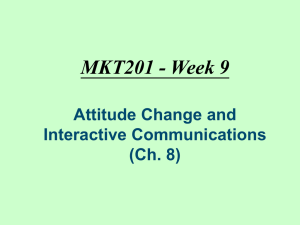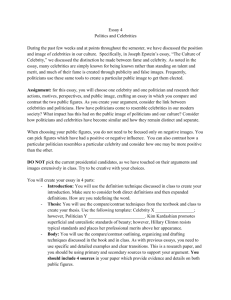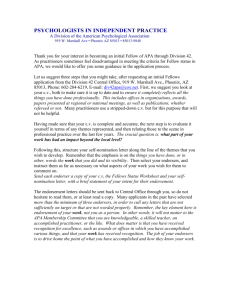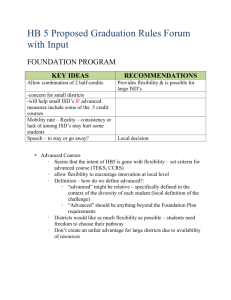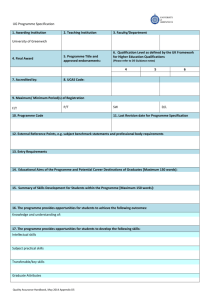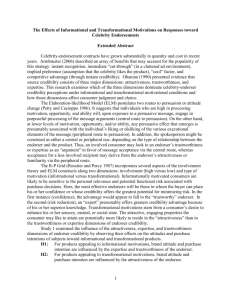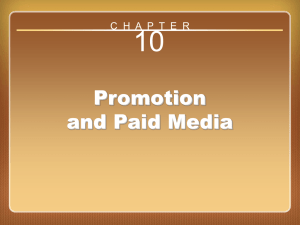Introduction - Association for Consumer Research
advertisement
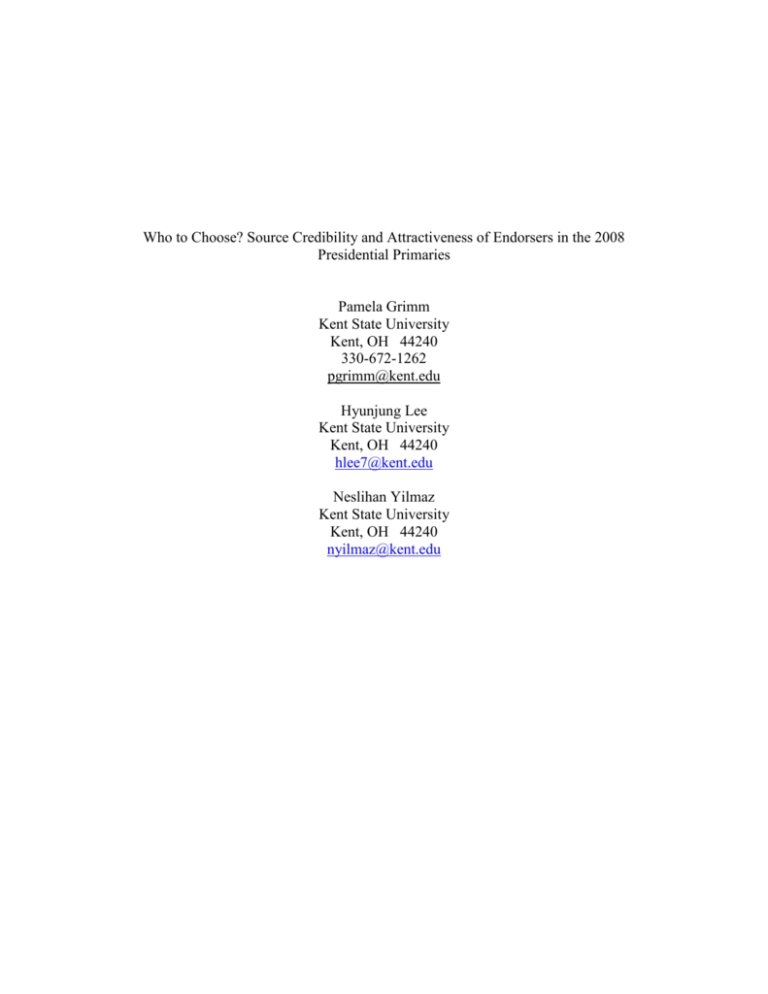
Who to Choose? Source Credibility and Attractiveness of Endorsers in the 2008 Presidential Primaries Pamela Grimm Kent State University Kent, OH 44240 330-672-1262 pgrimm@kent.edu Hyunjung Lee Kent State University Kent, OH 44240 hlee7@kent.edu Neslihan Yilmaz Kent State University Kent, OH 44240 nyilmaz@kent.edu Who to Choose? Source Credibility and Attractiveness of Endorsers in the 2008 Presidential Primaries Endorsements in politics are ubiquitous, especially in the run-up to a presidential election. Though both marketers and politicians try to influence consumer/voter behavior through endorsements, the endorsement process in politics is more complicated than in marketing for several reasons. First, in marketing the endorser is usually a celebrity or expert on the product category, is paid for his or her endorsement and, typically, an endorsement is not made unless a relationship (usually contractual) exists between the firm and the endorser. In politics, celebrity endorsements seem less important that endorsements from sources such as other politicians. Endorsements in politics are not paid, there are no contractual relationships and some endorsements are rejected by the candidate because they are viewed as liabilities rather than assets. This rejection of an endorsement is a phenomenon seldom seen outside of the political arena. It is especially clear in the 2008 Presidential Primary that endorsements matter. The campaigns make a point of sharing news about positive endorsements and several candidates have found themselves in the position of either having to reject or explain endorsements from sources viewed as negative by some voters. Yet, despite this obvious importance, there is only a limited understanding of the relative importance of different types of endorsers or the factors that drive the importance of an endorser. This research provides insight into four broad categories of endorsers. These categories are: politicians, newspapers, organizations representing interest groups (ex: labor and religious groups) and celebrities. Evidence of the importance of most of these types of endorsements is found primarily in the Political Science literature, though the popular press has also been weighing in on this question as well. Political endorsements (Schulte 2008; Thomas 2008; Tumulty 2008), newspaper endorsements (Cooper,2007; Erikson 1976; Stengel 2008), interest group endorsements (Grossman & Helpman 1999; Maher 2008; McDermott 2006; Rapoport, Stone, & Abramowitz 1991), and celebrity endorsements (Celeb in chief 2007; Goodnight 2005; Jones & Carroll 2007; Payne, Hanlon, & Twomey III 2007; Weiskel 2005) have all been studied, though typically in isolation from other types of endorsements. This paper examines and compares these different types of endorsers utilizing the Source Credibility and, in the case of celebrities, the Source Attractiveness models of endorser effects (Ohanian 1990). Application of these models in the context of political endorsements has not been done, though this application was suggested by Ohanian (1990). Using these models should provide greater insight into the mechanisms underlying endorsement effects in a political context. Subjects in the research were undergraduate students from an Ohio public university who were given extra credit for participating in the research. The survey was administered online and was made available 36 hours before the March 2008 Primary in Ohio. The survey included items designed to gather information regarding party affiliation, primary candidate preferences, source credibility for each of the four categories of endorsers (politicians, newspapers, interest groups and celebrities) and attractiveness and importance of eight specific endorsers. Subjects rated two actual endorsers for each of the four categories of endorsers, for a total of eight endorsers. The eight specific endorsers rated by a subject depended on the subject’s primary candidate preference. The items used for source credibility and attractiveness were those developed by Ohanian (1990). A single seven point item (with 1 as “not at all important” and 7 as “very important”) was used to gauge the importance that a subject assigned to a given endorser. Overall, 355 surveys were retained; 85 respondents were registered Republicans, 135 were Democrats and 40 were independent. The remaining subjects were not registered. The source credibility items were administered to all subjects, but the source attractiveness and importance items were only administered to those subjects who were registered to vote. The ten items representing source credibility were averaged, as were the five items representing source attractiveness. The results demonstrate that, in general, consumers/voters evaluate the different endorsers in significantly different ways based on source credibility. Other politicians are viewed as most credible (mean = 4.9 average on a seven point scale), followed by newspapers (4.3), interest groups (4.2) and celebrities (3.6) (p<.001). The rank ordering produced by the Source Credibility items is mirrored in the importance ratings assigned to the specific celebrities in each category for each candidate. The average importance for politicians was 4.7; for newspapers 4.3; for interest groups 3.9 and for celebrities 2.9. Politicians are considered most credible and important and celebrities are considered least credible and important. The Source Credibility scale can be further decomposed into two sub-factors: trustworthiness and expertise. A factor analysis of the scale items for each of the four categories of endorsers showed that the pattern of factor loadings followed the results of Ohanian except for celebrity endorsers. Means were computed on the two sub-factors for politicians, newspapers and interest groups. Results show significant differences between the three groups in terms of trustworthiness and expertise. Politicians are rated higher in terms of both expertise (5.42) and trustworthiness (4.39) than the other two groups, though the difference between politicians and interest groups, in terms of trustworthiness, is not significant. Newspapers are rated second in terms of expertise (4.49) but third, behind interest groups, in terms of trustworthiness (4.14). Interest groups are not significantly different from politicians in terms of trustworthiness (4.31) but are significantly lower than politicians and newspapers in terms of expertise (4.17). Source attractiveness measures were collected for the two celebrities endorsing each of the four specific candidates. The average attractiveness measure was 4.11 across the eight celebrities included in the study. The relationship between attractiveness and the importance assigned the endorser was positive and significant (r = .406, p<.001). This research demonstrates the value of utilizing the Source Credibility and Attractiveness framework in a political context. There are significant differences in how different types of endorsers are viewed in terms of credibility in general, and trustworthiness and expertise in particular. Further, credibility is mirrored in the importance assigned to endorsers by consumers. Celebrity attractiveness is also linked to the importance assigned to a celebrity’s endorsement. References "Celeb in chief," (2007), Time, 170 (26), 25. Cooper, Christopher (2007), "Odds are on obama to get iowa paper's endorsement," Wall Street Journal - Eastern Edition, 250 (141), A2. Erikson, Robert S. (1976), "The influence of newspaper endorsements in presidential elections: The case of 1964," American Journal of Political Science, 20 (2), 207-33. Goodnight, G. T. (2005), "The passion of the christ meets fahrenheit 9/11: A study in celebrity advocacy," American Behavioral Scientist, 49 (3), 410-35. Grossman, Gene M., and Elhanan Helpman (1999), "Competing for endorsements," The American Economic Review, 89 (3), 501-24. Jones, Jeffrey M., and Joseph Carroll (2007), "Most voters not moved by oprah's endorsement of obama: Majority say endorsements generally not an important factor in vote," Gallup Poll Briefing, , 16-21. Maher, Kris (2008), "Key union may back obama run," Wall Street Journal - Eastern Edition, 251 (7), A9. McDermott, Monika L. (2006), "Not for members only: Group endorsements as electoral information cues," Political Research Quarterly, 59 (2), 249-57. Ohanian, Roobina (1991), "The impact of celebrity spokespersons' perceived image on consumers' intention to purchase," Journal of Advertising Research, 31 (1), 46-54. Payne, J. G., John P. Hanlon, and David P. Twomey III (2007), "Celebrity spectacle influence on young voters in the 2004 presidential campaign: What to expect in 2008," American Behavioral Scientist, 50 (9), 1239-46. Rapoport, Ronald B., Walter J. Stone, and Alan I. Abramowitz (1991), "Do endorsements matter? group influence in the 1984 democratic caucuses," The American Political Science Review, 85 (1), 193-203. Schulte, Bret (2008), "Endorsement envy. (cover story)," U.S.News & World Report, 144 (6), 41. Stengel, Richard (2008), "Taking sides," Time, 171 (9), 6. Thomas, Evan (2008), "Welcome to the family," Newsweek, 151 (6), 37. Tumulty, Karen (2008), "Endorsement politics," Time, 171 (6), 50. Weiskel, T. C. (2005), "From sidekick to sideshow-celebrity, entertainment, and the politics of distraction: Why americans are "sleepwalking toward the end of the earth," American Behavioral Scientist, 49 (3), 393-409.
